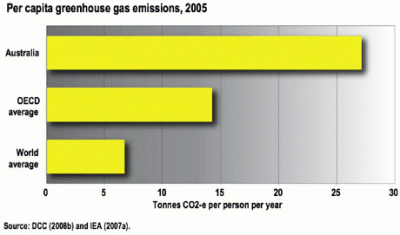Ross Garnaut’s recipe for climate action treads a fine line between political and physical reality. Tasmania needs to pay careful heed to the Garnaut Report’s implications. [8 July 2008 | Peter Boyer]
George Bush won’t move on climate unless the Indians and the Chinese go first. Federal Opposition Leader Brendan Nelson won’t commit to an Australian emissions trading scheme ahead of other countries making similar commitments. It’s hard to find leadership in these tough times.

As Ross Garnaut's report makes clear, Australia's per-capita emissions are four times the world average and twice the average of developed countries.
But cometh the hour… Professor Ross Garnaut’s draft report says that Australia, which has more to lose from climate change than any other developed country, can’t afford to wait for others. George, Brendan – and Kevin – this is leadership.
The value of this report (like its readership) is deep and broad. Garnaut looks beyond the governments that are funding his work and appeals directly to Australians to stand up and face the unprecedented trial ahead.
It’s not purple prose that gives this report its power, but the opposite – plain, simple text with the unadorned message that we can choose to act decisively now and give ourselves a chance, or face a tougher future with virtually no potential for success.
The fact that Garnaut is dealing with everything that we do as citizens, businesses and governments ensured this would be no ordinary report. But he has gone further than most Australians, including many in the governments who employed him, would have expected.
For nearly half of the report’s 500 pages, Garnaut brings together countless threads of information to describe the physical nature and impact of today’s climate from an Australian perspective. The shocking picture includes lost national treasures such as the Great Barrier Reef and yet more frequent and devastating droughts and extreme events.
Globally we’re pumping out more greenhouse gases than ever, well above the worst-case scenarios on which the Intergovernmental Panel on Climate Change based its 2007 analysis. In Australia, as Garnaut’s troubling graph on page 200 puts in sharp focus, our own contribution is way above what our population level suggests should be the case.
It’s undeniable, based on the evidence marshalled by Garnaut, that climate change presents Australia with a colossal problem.
Garnaut supports the 2010 schedule for introducing emissions trading. The fact that this is opposed by both coal interests (which see this as unduly hasty) and conservationists (who say a proposed two-year lead-in period is too tentative) would suggest he’s close to the mark.
But there’s disagreement on economic matters. Garnaut’s economic model is said to have problems in addressing efficient energy use. His opposition to free permits for big polluters is (as you’d expect) being challenged by coal and transport interests, and his preference for a European-style cap-and-trade system is seen by some as too inflexible in a changing world economy.
For Tasmania there are a number of considerations, not least being how we get our emissions down when low hydro storages and consequently-rising imports of Victorian coal-fired power are pushing our emissions in the opposite direction.
But for this state the big question-mark from Garnaut’s report, overshadowing all else, is the future of forestry, and here we have to read between the lines.
Garnaut is pushing for Australia’s trading scheme to include regional agreements bringing in countries like Papua New Guinea and Indonesia, where tropical forest logging is producing emissions out of all proportion to their general economy.
For the scheme to stop these dangerous practices, Australia will have to reverse a situation that has been in place since the 1997 Kyoto agreement, under which forestry activities were excluded from official greenhouse figures. If we enter a regional forestry partnership with other countries, we will have to count our own logging emissions.
There’s strong scientific evidence that even taking account of carbon stored in wood products and taken up by new growth, clearfelling of Tasmania’s mature native forest makes forestry overall a big net emitter, very likely our biggest.
Tasmanian policy-makers and business leaders will be well-advised to take Garnaut very seriously. They must see climate change not as an abstract scientific idea but a real, physical occurrence that’s with us now. Understanding that hiding issues will only make matters worse long-term, they must think hard about the big questions for Tasmania and plan accordingly.
The Garnaut road-show kicks off this week, but Tasmanians are off the agenda until October, after the release of the final report. That’s a pity. I think he’d have been impressed by the strong interest in the subject here, and would himself have gained from local knowledge.
But we don’t need Ross Garnaut’s presence to show some leadership of our own. Do we?
